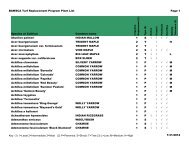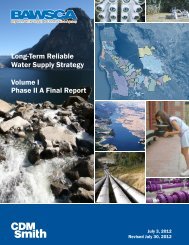SFPUC Wholesale Customer Water Demand Projections ... - BAWSCA
SFPUC Wholesale Customer Water Demand Projections ... - BAWSCA
SFPUC Wholesale Customer Water Demand Projections ... - BAWSCA
Create successful ePaper yourself
Turn your PDF publications into a flip-book with our unique Google optimized e-Paper software.
SECTIONFOUR<br />
<strong>Water</strong> <strong>Demand</strong> Forecasting<br />
Agency Population Projection Source Selection<br />
The DSS population projections were tabulated in 5-year increments and graphed for each<br />
wholesale customer. Each of these population projections was then applied in the DSS model to<br />
create preliminary water demand projections with and without plumbing codes, which were also<br />
tabulated, graphed, and submitted to the wholesale customers.<br />
Each wholesale customer was asked to select one of the population projection sources based on<br />
the unique characteristics of their service area and consistency with local land use plans and<br />
policies. The exception to this is Stanford University. Residential account growth for Stanford<br />
University was projected using increase in dwelling units rather than population projections.<br />
Table 4-1 summarizes each wholesale customer’s population projection source selection, 2001<br />
base-year population, and corresponding 2030 population derived using the methodology<br />
outlined above.<br />
4.2.2 Use of Employment <strong>Projections</strong><br />
As described above, the DSS model uses growth in number of accounts and end uses to estimate<br />
future water demands. For each wholesale customer, the 2001 estimated service area<br />
employment (total jobs in service area) was directly related to the number of 2001 commercial<br />
and industrial accounts. Growth in those accounts was estimated using an employment growth<br />
rate or, in two cases, a total population growth rate. Table 4-1 summarizes 2001 DSS<br />
employment and 2030 employment projections for each wholesale customer based on the growth<br />
rate from their selected projection source for commercial and industrial accounts. An<br />
employment projection was not developed for Los Trancos County <strong>Water</strong> District (LTCWD) or<br />
Stanford University. LTCWD includes only residential accounts. Stanford University used other<br />
parameters such as increase in building square footage to forecast growth in Non-Residential<br />
accounts.<br />
ABAG was the only published source of employment projections available for the <strong>SFPUC</strong><br />
wholesale customers. For each wholesale customer, yearly service area employment growth rates<br />
were developed for the years 2001 to 2030 using the methodology described in Section 4.2.1<br />
above. ABAG service area blends, summarized in Table 3-4, were used to create the service area<br />
specific employment growth rates and projections.<br />
4.3 PLUMBING CODES AND NATURAL REPLACEMENT RATES<br />
In the forecasting process of the DSS model, fixture models incorporate the effects of natural<br />
replacement and plumbing codes to adjust the end-use water usage over time using a yearly<br />
average of fixture conditions for accounts with applicable end uses, including base-year existing<br />
accounts and new accounts. Natural replacement of a fixture occurs due to failure, aging, or<br />
remodeling. Plumbing codes require that new and replacement fixtures meet specified standards<br />
of efficiency. Table 3-9 lists the historical and current plumbing codes.<br />
4-4







